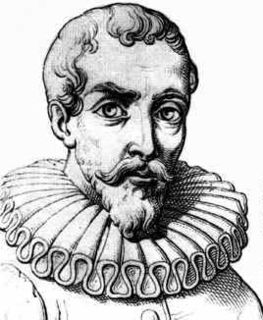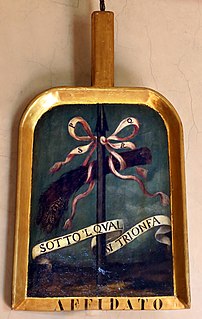
The Galilean moons, or Galilean satellites, are the four largest moons of Jupiter: Io, Europa, Ganymede, and Callisto. They were first seen by Galileo Galilei in December 1609 or January 1610, and recognized by him as satellites of Jupiter in March 1610. They were the first objects found to orbit a planet other than the Earth.

The House of Medici was an Italian banking family and political dynasty that first began to gather prominence under Cosimo de' Medici, in the Republic of Florence during the first half of the 15th century. The family originated in the Mugello region of Tuscany, and prospered gradually until it was able to fund the Medici Bank. This bank was the largest in Europe during the 15th century and facilitated the Medici’s rise to political power in Florence, although they officially remained citizens rather than monarchs until the 16th century.

Sidereus Nuncius is a short astronomical treatise published in New Latin by Galileo Galilei on March 13, 1610. It was the first published scientific work based on observations made through a telescope, and it contains the results of Galileo's early observations of the imperfect and mountainous Moon, the hundreds of stars that were unable to be seen in either the Milky Way or certain constellations with the naked eye, and the Medicean Stars that appeared to be circling Jupiter.

Christina of Lorraine or Christine de Lorraine was a member of the House of Lorraine and was the Grand Duchess of Tuscany by marriage. She served as Regent of Tuscany jointly with her daughter-in-law during the minority of her grandson from 1621 to 1628.

Ferdinando II de' Medici was grand duke of Tuscany from 1621 to 1670. He was the eldest son of Cosimo II de' Medici and Maria Maddalena of Austria. He was remembered by his contemporaries as a man of culture and science, actively participating in the Accademia del Cimento, the first scientific society in Italy, formed by his younger brother, Leopoldo de' Medici. His 49-year rule was punctuated by the beginning of Tuscany's long economic decline, which was further exacerbated by his successor, Cosimo III de' Medici. He married Vittoria della Rovere, a first cousin, with whom he had two children who reached adulthood: the aforementioned Cosimo III, and Francesco Maria de' Medici, Duke of Rovere and Montefeltro, a cardinal.

Cosimo II de' Medici was Grand Duke of Tuscany from 1609 until his death. He was the elder son of Ferdinando I de' Medici, Grand Duke of Tuscany, and Christina of Lorraine.

Guidobaldo del Monte, Marquis del Monte, was an Italian mathematician, philosopher and astronomer of the 16th century.

Justus Sustermans, Joost Sustermans or Suttermans, his given name Italianised to Giusto, was a Flemish painter and draughtsman who is mainly known for his portraits. He also painted history and genre paintings, still lifes and animals.

Leopoldo de' Medici was an Italian cardinal, scholar, patron of the arts and Governor of Siena. He was the brother of Ferdinando II de' Medici, Grand Duke of Tuscany.

Giulio Strozzi was a Venetian poet and libretto writer. His libretti were put to music by composers like Claudio Monteverdi, Francesco Cavalli, Francesco Manelli, and Francesco Sacrati. He sometimes used the pseudonym Luigi Zorzisto.

Museo Galileo, the former Istituto e Museo di Storia della Scienza is located in Florence, Italy, in Piazza dei Giudici, along the River Arno and close to the Uffizi Gallery. The museum, dedicated to astronomer and scientist Galileo Galilei, is housed in Palazzo Castellani, an 11th-century building which was then known as the Castello d’Altafronte.

Filippo Vincenzo Romolo Salviati was an Italian nobleman, scientist and friend of Galileo. He is remembered today mainly because he appears as one of the figures in Galileo's controversial work the Dialogue Concerning the Two Chief World Systems (1632).

Antonio Francesco Gori, on his titlepages Franciscus Gorius, was a Florentine antiquarian, a priest in minor orders, provost of the Baptistery of San Giovanni from 1746, and a professor at the Liceo, whose numerous publications of ancient Roman sculpture and antiquities formed part of the repertory on which 18th-century scholarship as well as the artistic movement of neoclassicism were based. In 1735 he was a founding member of a circle of antiquaries and connoisseurs in Florence called the Società Colombaria, the predecessor of the Accademia Toscana di Scienze e Lettere la Colombaria, to foster "not only Tuscan Poetry and Eloquence, or one faculty only; but almost all the most distinguished and useful parts of human knowledge: in a word, it is what the Greeks called Encyclopedia".

Mario Cartaro was an engraver, draftsman, and print merchant.

The Bregans lens is a large lens, mounted in a gilt wooden frame, with a focal length of 1,580 mm. Another smaller lens acts as a condenser and can be positioned by means of a sliding mechanism along a supporting track. Beyond the condenser is a small adjustable metal plate for holding specimens. The wooden mount on a small table fitted with castors, dated 1767, is the work of the Florentine artisan Francesco Spighi; the metal parts are signed by Gaspero Mazzeranghi. The maker of the lens, Benedetto Bregans, donated it to Cosimo III de' Medici in 1697. The instrument was used some time later by Giuseppe Averani and Cipriano Targioni for experiments on the combustion of diamonds and other precious stones. In 1814, Humphry Davy — on a visit to Florence with Michael Faraday — used the lens to repeat Averani's experiments. In 1860, Giovanni Battista Donati mounted the lens on a tube for use as a starlight condenser to observe the absorption bands of stellar spectra.

Galileo's objective lens is a specific objective lens held in the Museo Galileo, Florence, Italy. It was used by Galileo Galilei in the Galilean telescope with which he discovered the four largest moons of Jupiter in 1610. The lens has a diameter of 38mm and a gilt brass housing. The frame is made of ebony and ivory and has dimensions of 410mm x 300mm.
The Campani compound microscope is a microscope on exhibit at the Museo Galileo in Italy, thought to have been built by optical instrument maker Giuseppe Campani in the second half 17th century. For a time it was thought to have been built by Italian scientist Galileo Galilei but no longer bares that attribution.

Lodovico delle Colombe was an Italian Aristotelian scholar, famous for his battles with Galileo Galilei in a series of controversies in physics and astronomy.
Tommaso Rinuccini was an Italian noble, diplomat and friend of Galileo Galilei.

Niccolò Arrighetti was Italian intellectual, pupil and associate of Galileo Galilei.

















